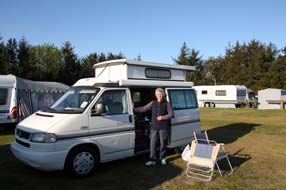|
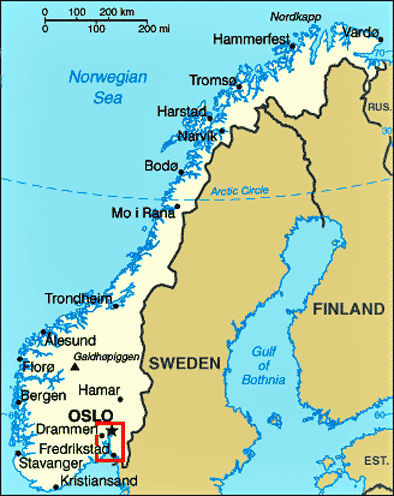 CAMPING
IN NORWAY 2014 - Norway's capital city Oslo: CAMPING
IN NORWAY 2014 - Norway's capital city Oslo:
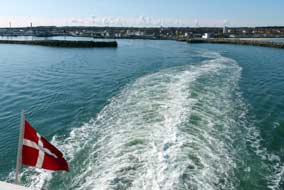 The
outward journey: this year we had another 2-stage journey out
with the DFDS overnight ferry from Harwich to Esbjerg on the west coast of
Denmark and an afternoon's drive up through Jutland to the northern port of Hirtshals. After a frosty night's camp, the final leg of outward journey was
by Fjordline ferry across the Skagerrak to Langersund on the southern coast of Norway. The
Spring morning was beautifully sunny, the air still with not a ruffle of breeze, and
the notorious straits between Denmark and Norway were flat calm; we took our
departing photos of Hirtshals (see left) and settled into the comfortable
bow-lounge for the 4½ hour crossing. By 1-00pm the southern coastline of Norway
was growing closer, the low mountains covered with a dusting of overnight snow.
As the ferry approached the little port of Langersund, nudging slowly along the
narrow channel between the off-shore islands, we took our arrival photos (Photo 1 - Arriving at Langersund)
and very soon were driving onto Norwegian tarmac; our 2014 travel venture had
truly begun. The
outward journey: this year we had another 2-stage journey out
with the DFDS overnight ferry from Harwich to Esbjerg on the west coast of
Denmark and an afternoon's drive up through Jutland to the northern port of Hirtshals. After a frosty night's camp, the final leg of outward journey was
by Fjordline ferry across the Skagerrak to Langersund on the southern coast of Norway. The
Spring morning was beautifully sunny, the air still with not a ruffle of breeze, and
the notorious straits between Denmark and Norway were flat calm; we took our
departing photos of Hirtshals (see left) and settled into the comfortable
bow-lounge for the 4½ hour crossing. By 1-00pm the southern coastline of Norway
was growing closer, the low mountains covered with a dusting of overnight snow.
As the ferry approached the little port of Langersund, nudging slowly along the
narrow channel between the off-shore islands, we took our arrival photos (Photo 1 - Arriving at Langersund)
and very soon were driving onto Norwegian tarmac; our 2014 travel venture had
truly begun.
|
Click on highlighted area of map
for
details of
Oslo |
 |
The drive up to Oslo:
the lane from the port rose steeply to join the
E18 eastwards to Oslo. Although classed as motorway, the craggy, hilly terrain
meant a single-carriageway road passing through frequent tunnels and crossing
fjords on high-arching bridges. As we drew closer to the broader Oslo
conurbation, 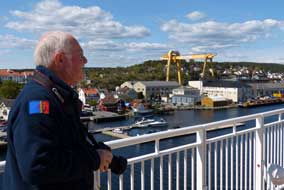 traffic became heavier and speed limits
lower, and once within the
main area of the city the satnav guided us through residential areas to reach Bogstad Camping,
which was to be our base for our 3 days in the capital. Set at the foot of
wooded hills in Oslo's northern suburbs 9kms from the city centre, Bogstad
Camping is run by NAF, the Norwegian equivalent of the AA/RAC: reception staff
were helpfully welcoming providing street plan and details and tickets for the
#32 bus which runs regularly to/from the centre; facilities were rather
care-worn but the setting was pleasantly green and wooded with plenty of space;
there was a well-stocked mini-market next door and wi-fi at reception. But the
prices! 340 NOK/night (£34) was unprecedentedly exploitational even for NAF. But
there was little choice since this was the only
campsite open in early May. We settled in as the evening became chill, looking
forward to our 3 days exploring Norway's capital city. traffic became heavier and speed limits
lower, and once within the
main area of the city the satnav guided us through residential areas to reach Bogstad Camping,
which was to be our base for our 3 days in the capital. Set at the foot of
wooded hills in Oslo's northern suburbs 9kms from the city centre, Bogstad
Camping is run by NAF, the Norwegian equivalent of the AA/RAC: reception staff
were helpfully welcoming providing street plan and details and tickets for the
#32 bus which runs regularly to/from the centre; facilities were rather
care-worn but the setting was pleasantly green and wooded with plenty of space;
there was a well-stocked mini-market next door and wi-fi at reception. But the
prices! 340 NOK/night (£34) was unprecedentedly exploitational even for NAF. But
there was little choice since this was the only
campsite open in early May. We settled in as the evening became chill, looking
forward to our 3 days exploring Norway's capital city.
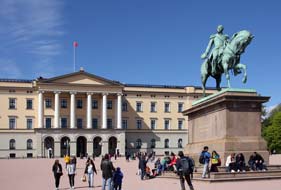 Oslo's
history: the oldest of the Scandinavian capital cities, Oslo's name is
derived from Old Norse words Às and Lo (meaning God's field). The
city was founded by Harald Hårdråda around 1048 and his son Olav Kyrre
established a bishopric there building a cathedral in the developing city. But
at this time royal power was based at Bergen until Håkon V moved the capital to
Oslo in the early 14th century fortifying the city with the Akershus castle. In
1349 bubonic plague wiped out half the population and the decline continued when
Norway fell under Danish control in 1397 with Oslo becoming a neglected
backwater. The city's fortunes revived in 1624 when the Danish King Christian IV
moved the city to its present site, modestly renaming it Christiana. The new
city prospered even after Norway was united with Sweden in 1814 and Jean-Baptiste
Bernadotte as King Karl XIV Johan built himself a grand new palace in Christiana
(see right) for the now united Kingdom of Sweden and Norway. Norway eventually
achieved her independent statehood in 1905, and the city finally regained its
original name of Oslo in 1925. Oslo's
history: the oldest of the Scandinavian capital cities, Oslo's name is
derived from Old Norse words Às and Lo (meaning God's field). The
city was founded by Harald Hårdråda around 1048 and his son Olav Kyrre
established a bishopric there building a cathedral in the developing city. But
at this time royal power was based at Bergen until Håkon V moved the capital to
Oslo in the early 14th century fortifying the city with the Akershus castle. In
1349 bubonic plague wiped out half the population and the decline continued when
Norway fell under Danish control in 1397 with Oslo becoming a neglected
backwater. The city's fortunes revived in 1624 when the Danish King Christian IV
moved the city to its present site, modestly renaming it Christiana. The new
city prospered even after Norway was united with Sweden in 1814 and Jean-Baptiste
Bernadotte as King Karl XIV Johan built himself a grand new palace in Christiana
(see right) for the now united Kingdom of Sweden and Norway. Norway eventually
achieved her independent statehood in 1905, and the city finally regained its
original name of Oslo in 1925.
Our first day in Oslo - Cathedral, National Theatre and University: the city bus stop was immediately outside
the campsite for the 30 minute ride into Oslo (Photo 2 - Morning bus into Oslo)
- remember to validate the ticket (valid for an hour) on entering the bus.
We got off at Sentral Station and getting our bearings, walked over to Jernbane-torget, the square in front of the railway station. In dull morning
light we began our stroll along the city's main shopping street Karl Johans
gata to Oslo's Dom kirke. Looking very dour and Lutheran from the outside, the cathedral's interior
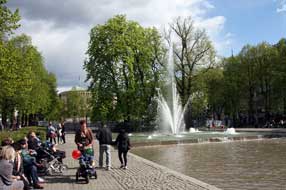 was a feast of
elegant Baroque decoration, particularly the maroon, green and gold ceiling
paintings. Opposite the exuberantly Baroque pulpit, the Royal Box with Håkon
VII's monogram (Norway's first king after 1905 independence) looked as if
borrowed from the Opera House. Behind the choir too distant for close
examination, the Baroque high altar was decorated with a relief of the Last
Supper (Photo 3 - Oslo Cathedral Baroque high altar). We crossed to Stortorvet just
opposite the cathedral, was a feast of
elegant Baroque decoration, particularly the maroon, green and gold ceiling
paintings. Opposite the exuberantly Baroque pulpit, the Royal Box with Håkon
VII's monogram (Norway's first king after 1905 independence) looked as if
borrowed from the Opera House. Behind the choir too distant for close
examination, the Baroque high altar was decorated with a relief of the Last
Supper (Photo 3 - Oslo Cathedral Baroque high altar). We crossed to Stortorvet just
opposite the cathedral,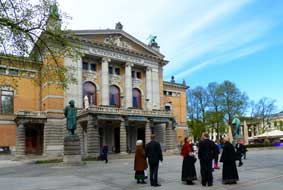 once the city's main square adorned with a statue of
Christian IV who revived the city's fortune and renamed it Christiana in his own
honour; his royal presence now supervises a small flower market (Photo
4 - Oslo Cathedral and Christian IV's statue at Stortorvet). Just along
Karl Johans gate we reached the Storting, the Norwegian Parliament, expecting
to join the Saturday morning visit; our whole trip's start had been scheduled
around this. We were greeted however with a sign on the locked door announcing
that public visits were cancelled today - that was that. Overwhelmed with
disappointment, we had no choice but to walk on through the elongated gardens
which lead down to the National Theatre.
Local people sat by the fountains or like us strolled through the park
in the morning sunshine (see left). (Photo 5 -
City fountains by the National Theatre). This led us to the 1899
Neo-Classical National Theatre fronted by statues of Norway's 2
renowned writers Ibsen and Bjørnson (see right)
(Photo 6 - Oslo's National Theatre).
Just opposite we crossed to the University of Oslo's grandiose main building
fronted with classical columns,
hoping rather over-optimistically to gain entry to the Aula to see the huge
murals painted in the first decade of the 20th century by Edvard Munch between
his bouts of alcoholism and depression. The building was securely locked and
deserted at this time of year (Photo 7 - Oslo University). once the city's main square adorned with a statue of
Christian IV who revived the city's fortune and renamed it Christiana in his own
honour; his royal presence now supervises a small flower market (Photo
4 - Oslo Cathedral and Christian IV's statue at Stortorvet). Just along
Karl Johans gate we reached the Storting, the Norwegian Parliament, expecting
to join the Saturday morning visit; our whole trip's start had been scheduled
around this. We were greeted however with a sign on the locked door announcing
that public visits were cancelled today - that was that. Overwhelmed with
disappointment, we had no choice but to walk on through the elongated gardens
which lead down to the National Theatre.
Local people sat by the fountains or like us strolled through the park
in the morning sunshine (see left). (Photo 5 -
City fountains by the National Theatre). This led us to the 1899
Neo-Classical National Theatre fronted by statues of Norway's 2
renowned writers Ibsen and Bjørnson (see right)
(Photo 6 - Oslo's National Theatre).
Just opposite we crossed to the University of Oslo's grandiose main building
fronted with classical columns,
hoping rather over-optimistically to gain entry to the Aula to see the huge
murals painted in the first decade of the 20th century by Edvard Munch between
his bouts of alcoholism and depression. The building was securely locked and
deserted at this time of year (Photo 7 - Oslo University).
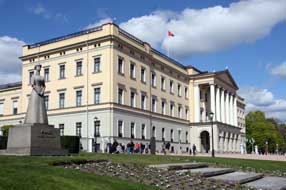 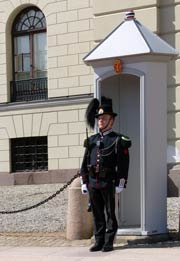 The
Royal Palace: in the now bright sunshine, we walked on towards the Kongelige
Slott (Royal
Palace) set on the hill ahead in the publically open parkland of Slottsparken
(Photo 8 - Royal Palace).
See the Royal House of Norway official web site
for details of the Norwegian monarchy
and Royal Family. At the top of the steps the equestrian statue of Jean-Baptiste
Bernadotte, alias Karl XIV Johan, King of united Sweden and Norway from 1814,
gazed imperiously over the city
(Photo 9 - Karl XIV Johan's statue gazing over Oslo). A small crowd of tourists and locals was
gathering for the 1-30pm daily changing of the guards ceremony. Two sentries
wearing tasselled bowler hats paraded in front of their sentry-boxes (see left), and a
squad of guards marched in for the change-over, all rather Nordically low-key
(Photo
10 - Changing of the Guards).
To one side of the palace stood a statue of a very dour-looking Queen Maud,
daughter of Edward VII of Great Britain and wife of Håkon VII the first king of
Independent Norway in the early 20th century (see right). The
Royal Palace: in the now bright sunshine, we walked on towards the Kongelige
Slott (Royal
Palace) set on the hill ahead in the publically open parkland of Slottsparken
(Photo 8 - Royal Palace).
See the Royal House of Norway official web site
for details of the Norwegian monarchy
and Royal Family. At the top of the steps the equestrian statue of Jean-Baptiste
Bernadotte, alias Karl XIV Johan, King of united Sweden and Norway from 1814,
gazed imperiously over the city
(Photo 9 - Karl XIV Johan's statue gazing over Oslo). A small crowd of tourists and locals was
gathering for the 1-30pm daily changing of the guards ceremony. Two sentries
wearing tasselled bowler hats paraded in front of their sentry-boxes (see left), and a
squad of guards marched in for the change-over, all rather Nordically low-key
(Photo
10 - Changing of the Guards).
To one side of the palace stood a statue of a very dour-looking Queen Maud,
daughter of Edward VII of Great Britain and wife of Håkon VII the first king of
Independent Norway in the early 20th century (see right).
Nobel Peace Centre: to one side of the harbour waterfront, the
Nobels Fredsenter (Nobel Peace Centre) (see left below) opened recently to celebrate the Nobel Peace
Prizes which are awarded annually in Oslo's modernistic City Hall. Alfred Nobel
secured his place in history bequeathing his fortune in 1901 with his Prizes for
Physics, Chemistry, Medicine, and Literature awarded in Stockholm; winners of
the Peace Prize are selected by a secretive committee of 5 appointed by the
Norwegian Parliament. Nobel achieved his ambition of being better remembered as
a philanthropist; it is generally forgotten that the money for his Prizes is
tainted with blood from the sale of arms and explosives
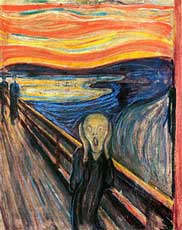 to bolster military
powers around the world. We had reservations about this visit, but entry to the
Centre was today half price and we soon found out why: half the exhibits were
closed for renovation. The 2013 nomination for the Peace Prize was to the
Organisation for Prohibition of Chemical Weapons, an international movement with
a challenging mission, since 2 of the main offenders, Russia and USA, despite
being signatories to the banning convention have done nothing to destroy their
monumental stock-piles of chemical weapons; terrorist groups and pariah
states like North Korea and Syria ignore the ban. to bolster military
powers around the world. We had reservations about this visit, but entry to the
Centre was today half price and we soon found out why: half the exhibits were
closed for renovation. The 2013 nomination for the Peace Prize was to the
Organisation for Prohibition of Chemical Weapons, an international movement with
a challenging mission, since 2 of the main offenders, Russia and USA, despite
being signatories to the banning convention have done nothing to destroy their
monumental stock-piles of chemical weapons; terrorist groups and pariah
states like North Korea and Syria ignore the ban. 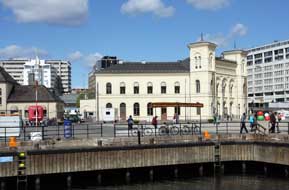 So the OPCW spends its time
cleaning up WW1 battlefields in Belgium. The Nobel Peace Centre's modernistic
display of light-bulbs-on-stalks listed past Peace Prize winners including such
worthy organisations and individuals as the International Committee of Red
Cross, Lech Wałęsa, Desmond Tutu, Martin Luther King, Nelson Mandela, Willy
Brandt and Mikhail Gorbachev. But over its 100 years of history, the Prize had
been awarded to some bizarrely dubious un-worthies like Theodore Roosevelt who
had extended US imperialism stirring up wars in Latin America, and Henry
Kissinger who had prolonged the Vietnam War by invading Cambodia. All in all we
were not impressed with the cynical Alfred Nobel, his Peace Prize or his Peace
Centre
(Photo 11 - Nobel Peace Centre). So the OPCW spends its time
cleaning up WW1 battlefields in Belgium. The Nobel Peace Centre's modernistic
display of light-bulbs-on-stalks listed past Peace Prize winners including such
worthy organisations and individuals as the International Committee of Red
Cross, Lech Wałęsa, Desmond Tutu, Martin Luther King, Nelson Mandela, Willy
Brandt and Mikhail Gorbachev. But over its 100 years of history, the Prize had
been awarded to some bizarrely dubious un-worthies like Theodore Roosevelt who
had extended US imperialism stirring up wars in Latin America, and Henry
Kissinger who had prolonged the Vietnam War by invading Cambodia. All in all we
were not impressed with the cynical Alfred Nobel, his Peace Prize or his Peace
Centre
(Photo 11 - Nobel Peace Centre).
Stortinget (Norwegian Parliament): we had thought to visit the
Nasjonalgalleriet (National Gallery) believing it to be free entry, but with the
introduction of steep admission charges, this scarcely seemed worth the cost
just to see Edvard Munch's celebrity daubing The Scream (see above right).
Instead we ambled back through the lovely central gardens back to the square in
front of the Parliament
(Photo 12 - Stortinget, the Norwegian Parliament).
On a pure whim we returned to the rear entrance, and got into chance
conversation with 2 people who had just come out of the building, telling them
of our disappointment that visits to parliament today had been cancelled and our
practice of always visiting our host country's parliament. It turned out they
were parliamentary officials and this seemed to raise their
interest.
After a word with the security staff over the intercom, they arranged to give us
a personal tour; St Serendipity was indeed working overtime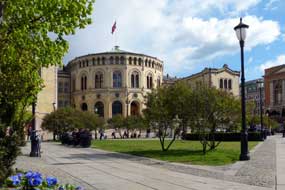 today
on our behalf! They introduced themselves as Peder and Oliver, and we arranged
to meet them an hour later by the main entrance at the Parliament's curved
frontage (see right). They both today
on our behalf! They introduced themselves as Peder and Oliver, and we arranged
to meet them an hour later by the main entrance at the Parliament's curved
frontage (see right). They both
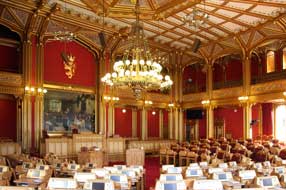 worked as Political Advisors for the governing Høyres stortingetsgruppe (Conservative Party Group) under Prime Minister Erna
Solberg, and led us into the main lobby of Parliament. Having passed through the
security screening, they showed us around the formal rooms and up the formal
staircase into the Storting's plenary chamber (see left). It was certainly the
most ornate parliamentary chamber we had seen, decorated in crimson and gilding
with the royal coat of arms above the President's (Speaker's) chair. The Norwegian Storting
became unicameral in 2009, with 169 Members elected by proportional
representation for a 4 year term from the 19 county-constituencies of Norway.
The constitution allows for no dissolution of parliament within the 4 year term
nor any by-elections; if any member dies in office or resigns (eg as Jens
Stoltenberg the Labour leader will to become Secretary General of NATO in
October 2014), the respective party is able to nominate a successor. Currently
the Norwegian government is formed by a Conservative (48 seats)/ Progress Party
(29 seats) coalition, with the Labour Party (55 seats) forming the Opposition.
There are 5 other parties with between 1 and 10 seats each). It was such a privilege
to be standing within Norway's Parliamentary Chamber looking over the Members
seats each with its electronic voting system; as in the Swedish Riksdag, Members sit within constituency groups regardless of
party
(Photo 13 - The Storting Parliamentary Chamber). worked as Political Advisors for the governing Høyres stortingetsgruppe (Conservative Party Group) under Prime Minister Erna
Solberg, and led us into the main lobby of Parliament. Having passed through the
security screening, they showed us around the formal rooms and up the formal
staircase into the Storting's plenary chamber (see left). It was certainly the
most ornate parliamentary chamber we had seen, decorated in crimson and gilding
with the royal coat of arms above the President's (Speaker's) chair. The Norwegian Storting
became unicameral in 2009, with 169 Members elected by proportional
representation for a 4 year term from the 19 county-constituencies of Norway.
The constitution allows for no dissolution of parliament within the 4 year term
nor any by-elections; if any member dies in office or resigns (eg as Jens
Stoltenberg the Labour leader will to become Secretary General of NATO in
October 2014), the respective party is able to nominate a successor. Currently
the Norwegian government is formed by a Conservative (48 seats)/ Progress Party
(29 seats) coalition, with the Labour Party (55 seats) forming the Opposition.
There are 5 other parties with between 1 and 10 seats each). It was such a privilege
to be standing within Norway's Parliamentary Chamber looking over the Members
seats each with its electronic voting system; as in the Swedish Riksdag, Members sit within constituency groups regardless of
party
(Photo 13 - The Storting Parliamentary Chamber).
Peder and Oliver suggested that before catching our bus back out to the
campsite at Voksen Skog, we visit the nearby area of government buildings where
in July 2011, Anders Breivik the lunatic terrorist had exploded a car bomb
killing passers by, before going on to a Labour Party youth camp on the island
of Utøya and murdering almost 80 teenagers. Work on repairing the public
buildings was still taking place.
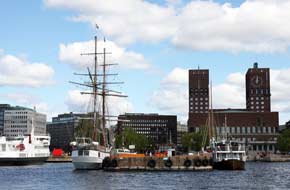 Our second day in Oslo - ferry across the Oslo Fjord to the Viking Ship
Museum and Fram Museum at Bygdøy: after a chill night, we again
caught the #32 bus into the city to spend our second day visiting 2 of the
museums on the peninsula of Bygdøy, crossing Oslo Fjord on the small ferry which
runs regularly from pier #3 at Rådhusbrygge behind the City Hall
(Photo 14 - Ferry across Oslo Fjord to Bygdøy). One
of the
civilised features of Norway is the price concessions generally available on
public transport and for admissions; an important word therefore to learn is
honnør meaning Our second day in Oslo - ferry across the Oslo Fjord to the Viking Ship
Museum and Fram Museum at Bygdøy: after a chill night, we again
caught the #32 bus into the city to spend our second day visiting 2 of the
museums on the peninsula of Bygdøy, crossing Oslo Fjord on the small ferry which
runs regularly from pier #3 at Rådhusbrygge behind the City Hall
(Photo 14 - Ferry across Oslo Fjord to Bygdøy). One
of the
civilised features of Norway is the price concessions generally available on
public transport and for admissions; an important word therefore to learn is
honnør meaning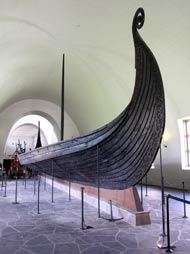 seniors' reduction. Bright morning sunshine lit the Oslo
waterfront and City Hall as the ferry crossed the fjord harbour (see left), and
within 10 minutes the boat pulled into the Dronningen dock on Bygdøy. From here
it was a short walk up the hill through a quiet residential suburb to the
Vikingskipshuset (Viking Ship Museum) on peninsula's crest. The large
cruciform building was specially constructed to house the remains of three
9th century AD Viking longboats recovered from burial mounds around the Oslo
Fjord at the turn of the 19/20th centuries. Viking custom was to bury its
chieftains in their ships accompanied by ritually killed slaves and all the
accoutrements needed for noble life in Valhalla. The acidic soil of the burial
mound covering the Bygdøy ships had preserved their oak timbers in almost
perfect condition. seniors' reduction. Bright morning sunshine lit the Oslo
waterfront and City Hall as the ferry crossed the fjord harbour (see left), and
within 10 minutes the boat pulled into the Dronningen dock on Bygdøy. From here
it was a short walk up the hill through a quiet residential suburb to the
Vikingskipshuset (Viking Ship Museum) on peninsula's crest. The large
cruciform building was specially constructed to house the remains of three
9th century AD Viking longboats recovered from burial mounds around the Oslo
Fjord at the turn of the 19/20th centuries. Viking custom was to bury its
chieftains in their ships accompanied by ritually killed slaves and all the
accoutrements needed for noble life in Valhalla. The acidic soil of the burial
mound covering the Bygdøy ships had preserved their oak timbers in almost
perfect condition.
The Oseberg ship, named after the farm where it was recovered from its burial
mound in 1904, filled the museum's first hall (see right). Built around 820 AD, the ship was
constructed of clinkered oak planking, and is 21.5m long and 5m wide, with
ornately carved prow and stern curving in an elegant sweep high above the hull
(Photo 15 - Conserved Oseberg Viking ship). 90%
of the ship's original timbers were conserved in the burial mound. It was of the
type used to navigate fjords and coastal waters, with a crew of 30 rowers plus
helmsman and lookout; oar ports along the sides of the hull showed the rowers'
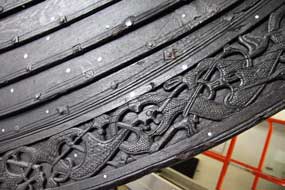 positions. The ship was uncovered with a large wooden burial chamber set on its
deck forward of the mast, with the skeletal remains of 2 women thought to be a
chieftain's wife and her attendant. It also contained a startling collection of
grave goods including 3 elaborately carved wooden sledges, a large wooden wagon,
ornately carved animal heads as well as a treasure trove of more mundane
domestic articles for use in the after life. We spent time photographing the
ship, its clinker-built planking and the detailed carvings along the length of the keel
(see left) which curved up to
the high prow and stern. Viewing galleries at each corner of the cruciform
centre of the halls allowed an overview of the ship's decking. positions. The ship was uncovered with a large wooden burial chamber set on its
deck forward of the mast, with the skeletal remains of 2 women thought to be a
chieftain's wife and her attendant. It also contained a startling collection of
grave goods including 3 elaborately carved wooden sledges, a large wooden wagon,
ornately carved animal heads as well as a treasure trove of more mundane
domestic articles for use in the after life. We spent time photographing the
ship, its clinker-built planking and the detailed carvings along the length of the keel
(see left) which curved up to
the high prow and stern. Viewing galleries at each corner of the cruciform
centre of the halls allowed an overview of the ship's decking.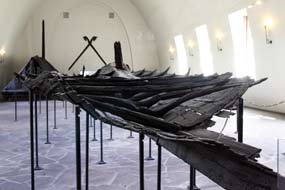
The second hall displayed the almost complete remains of the Viking ship
discovered at Gokstad, built around 890 AD and used as a burial ship for a
chieftain-warrior around 900 AD. Clinker-built of oak planks, the
ship is 23m long and 5m wide, a sturdier and more functional ocean-going vessel
with higher sides, heftier keel and wooden shutters to close the 32 oar ports
when the ship was under sail in rougher seas. It was found equipped with 32
shields, and in a wooden burial chamber on deck, the skeleton of a bigly-built
man in his 40s was discovered. The grave had been plundered in antiquity but
some of the grave goods survived. In the third hall, the remaining fragments of
the Tune ship were displayed unrestored exactly as excavated in 1867 (see right).
Dating from around 900 AD, the ship was probably a fast ocean-going vessel.
A man's body was found in the burial chamber along with weapons, a suit of chain
mail, pieces of a ski and skeleton of a horse. The 2 female skeletons from the Oseberg ship and warrior's skeleton were displayed in the Gokstad hall. The 2
females were small figures around 1.4m high, but the warrior-chieftain was a
sturdier figure, the incision wounds on the leg bones showing he had died a
violent death; nothing more is known of any of the interred. The fourth hall
displayed the graves goods and artefacts recovered from the ships' burial
mounds, including the huge and elaborately carved wooden wagon and 3 ornately
carved sledges (Photo 16 - Carved wooden sledge found with Oseberg ship). All in all, whether Viking history is your thing or not, the
Viking Ships Museum is certainly worth a visit and excellent value at 35 NOKs
(seniors' tickets)
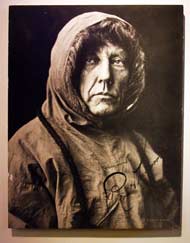 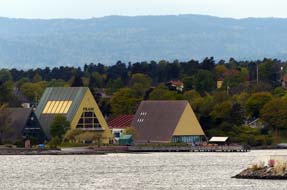 It
was a short walk down to the Bygdøy dock for the Fram Museum, which is made up
of 2 fjord-side huge triangular tent-shaped buildings housing the Fram and
Gjøa, the 2 boats associated with the polar expeditions of the 2 Norwegian
explorers Roald Amundsen (1872~1928) and Fridtjof Nansen (1861~1930),
(Photo 17 - The Fram Museum)
(see right). Just inside the
museum, the figures of Amundsen (stern features and characteristic hooked nose -
see left) and Nansen were readily identifiable from our visit last year to the Tromsø Polar Museum. The first building was dominated by the mammoth presence of
the polar ship Fram, designed by Colin Archer, a Norwegian ship builder
of Scots descent, with specially reinforced 3-layer hull rounded to resist
pressure of ice. Launched in 1892, its name Fram aptly in Norwegian means
'Forward'. It was first used on Nansen's 1893~96 North Pole expedition, when
Nansen planned to test his theory of east~west polar ice drift by sailing
eastwards around northern Russia and allowing the vessel to 'drift' westwards
trapped in the polar ice. After a year's such drifting, Nansen and a colleague
left the ship to attempt to reach the pole. Meanwhile Fram was
drifted/sailed SW-wards by Sverdrup, a scientific member of the expedition's
team. Nansen failed to reach the pole and headed
back on sledges eventually reaching the edge of the ice and, after
over-wintering in a stone hut, managed to reach Svalbard by kayak arriving 1
week ahead of Sverdrup in the Fram, and returned to Norway to a hero's
welcome. It
was a short walk down to the Bygdøy dock for the Fram Museum, which is made up
of 2 fjord-side huge triangular tent-shaped buildings housing the Fram and
Gjøa, the 2 boats associated with the polar expeditions of the 2 Norwegian
explorers Roald Amundsen (1872~1928) and Fridtjof Nansen (1861~1930),
(Photo 17 - The Fram Museum)
(see right). Just inside the
museum, the figures of Amundsen (stern features and characteristic hooked nose -
see left) and Nansen were readily identifiable from our visit last year to the Tromsø Polar Museum. The first building was dominated by the mammoth presence of
the polar ship Fram, designed by Colin Archer, a Norwegian ship builder
of Scots descent, with specially reinforced 3-layer hull rounded to resist
pressure of ice. Launched in 1892, its name Fram aptly in Norwegian means
'Forward'. It was first used on Nansen's 1893~96 North Pole expedition, when
Nansen planned to test his theory of east~west polar ice drift by sailing
eastwards around northern Russia and allowing the vessel to 'drift' westwards
trapped in the polar ice. After a year's such drifting, Nansen and a colleague
left the ship to attempt to reach the pole. Meanwhile Fram was
drifted/sailed SW-wards by Sverdrup, a scientific member of the expedition's
team. Nansen failed to reach the pole and headed
back on sledges eventually reaching the edge of the ice and, after
over-wintering in a stone hut, managed to reach Svalbard by kayak arriving 1
week ahead of Sverdrup in the Fram, and returned to Norway to a hero's
welcome.
The Fram was used again in 1910 by Amundsen who initially planned an
expedition to reach the North Pole. On hearing however of the American Robert
Peary's success in being the first to reach the North Pole, Amundsen turned the
Fram south (without telling his crew!), with the intention of attempting
to reach the South Pole. The Fram reached the Antarctic ice at Whale Bay
where the crew established a base, Framheim (see right), while Amundsen set off with his team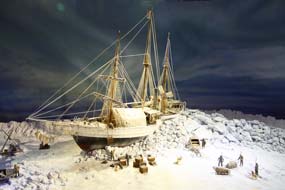 heading for the Pole. Applying the experience learnt from North Canadian Inuit
during his
heading for the Pole. Applying the experience learnt from North Canadian Inuit
during his
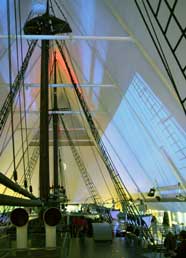 NW Passage expedition of 1903~06 in the Gjøa
of using windproof clothing (furs and anoraks) for protection and husky dogs to
haul sledges, he successfully reached the South Pole in 1912, beating his
British rival Captain Robert Scott by a month. The members of Scott's
expedition all perished on their return march from the Pole. Three galleries of
displays and exhibits told the story of Nansen and Amundsen's polar ventures in
commendable detail with excellent multi-lingual commentaries. From the highest
gallery, a gang-plank led across onto the Fram's deck (see left) with steps down
into the confined quarters of the ship with displays detailing the equipment
taken on the polar expedition
(Photo 18 - Amundsen's polar ship Fram). NW Passage expedition of 1903~06 in the Gjøa
of using windproof clothing (furs and anoraks) for protection and husky dogs to
haul sledges, he successfully reached the South Pole in 1912, beating his
British rival Captain Robert Scott by a month. The members of Scott's
expedition all perished on their return march from the Pole. Three galleries of
displays and exhibits told the story of Nansen and Amundsen's polar ventures in
commendable detail with excellent multi-lingual commentaries. From the highest
gallery, a gang-plank led across onto the Fram's deck (see left) with steps down
into the confined quarters of the ship with displays detailing the equipment
taken on the polar expedition
(Photo 18 - Amundsen's polar ship Fram).
The second building now houses the polar ship Gjøa (pronounced Yeu-a),
a sloop which had from 1872 served as an arctic sealing vessel until bought and
re-equipped by Amundsen for his 1903 attempt to discover the NW Passage. In 1903
he sailed the Gjøa past Greenland and successfully navigated a passage
between the polar ice and Northern Canada, establishing a base where he spent 2
winters studying the magnetic North Pole and learning much about arctic survival
techniques, clothing and equipment from the native Inuit. In the 3rd season he
sailed Gjøa westwards eventually reaching the Pacific off Northern
Alaska, the first man ever to navigate the NW Passage. The Gjøa reached
San Francisco in 1906 and remained there until finally returned to Norway on
board a larger ship. Amundsen returned home to a hero's welcome in Norway which
while he had been away had finally achieved its independence. The Gjøa
was conserved at the Fram Museum, and a series of superbly compiled,
multi-lingual displays detail the history of earlier failed attempts to discover
the fabled NW Passage and the story of Amundsen's remarkable 1903~06 achievement.
There was no doubt that Oslo's Fram Museum set a standard of presentation and
detailed, multi-lingual display panels which other museums would do well to
follow, and is well worth a visit.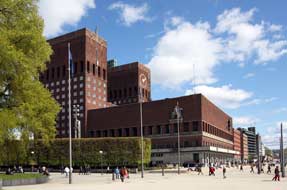
After such an excellent day of learning at the 2 museums, we walked around to
Bygdøy pier to await the ferry back across the fjord to Rådhusbrygge. The bright
sunlight of late afternoon lighting the waters of the harbour produced superb
views across the water of Akershus Slott, Oslo's medieval castle which we
should visit tomorrow (Photo 19 -
Akershus Slott).
Our third day in Oslo - Oslo City Hall (Rådhus): we caught the bus for the
now familiar journey into the city centre and walked down towards the harbour
for our first visit today at Oslo's City Hall. It is not
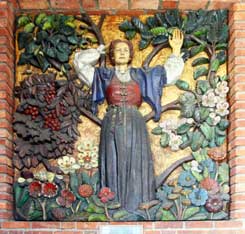 surprising that this
modernistic, cuboid, dark brick structure which with its twin square towers
which dominates the
waterfront, lacking any subtlety, grace or charm (see
right), had met initially with universal condemnation as a markedly un-Nordic
intrusion into the city's skyline. The original idea of a new city hall to be
built on an area of slum clearance by the harbour dated from 1915. Arneberg and
Poulsson won the architectural competition to create a grandiose statement of
city pride with their final design of 1930, combining, it was said, various
artistic trends of the period, national romanticism, classicism and
functionalism. Work began in 1931 to create the new harbour-side city centre
with the new City Hall towering over the ambitious development. WW2 delayed
completion and the building was finally opened in 1950. Now surrounded by even
more alien glass
and concrete structures, the City Hall has become accepted as
part of Oslo's city-scape, albeit still with its unique design (Photo 20 -
Oslo City Hall). surprising that this
modernistic, cuboid, dark brick structure which with its twin square towers
which dominates the
waterfront, lacking any subtlety, grace or charm (see
right), had met initially with universal condemnation as a markedly un-Nordic
intrusion into the city's skyline. The original idea of a new city hall to be
built on an area of slum clearance by the harbour dated from 1915. Arneberg and
Poulsson won the architectural competition to create a grandiose statement of
city pride with their final design of 1930, combining, it was said, various
artistic trends of the period, national romanticism, classicism and
functionalism. Work began in 1931 to create the new harbour-side city centre
with the new City Hall towering over the ambitious development. WW2 delayed
completion and the building was finally opened in 1950. Now surrounded by even
more alien glass
and concrete structures, the City Hall has become accepted as
part of Oslo's city-scape, albeit still with its unique design (Photo 20 -
Oslo City Hall).
We approached the long ramp which led up to City Hall's forecourt overshadowed
by the twin towers. The arcaded sides of the forecourt were lined with garishly
coloured wood-carved relief panels created by the Norwegian painter and sculptor
Dagfin Werenskiold illustrating themes from pagan Nordic myths (see left)
featuring Yggdrasil, the Tree of Life, Ragnarök, the twilight of the gods and
the Valkyries women warriors
(Photo 21 - Valkyries carved
relief panel).
Inside, the grand hall of Rådhushallen, its lofty marble heights lined with huge
murals, is the venue for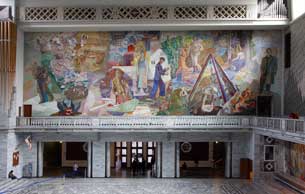 the Nobel Peace Prize award ceremony held each December
(Photo 22 - Oslo City Hall's Rådhushallen). The
east wall is lined with the Occupation Frieze depicting scenes from the 5 years
of 1940~45 German occupation and commemorating the Norwegian WW2 Resistance.
Henrik Sørensen's monumental vividly coloured fresco Work, Administration,
Celebration, 10 years in the painting, covers the south wall dominating the
hall. We climbed the ramp to the marble balustraded gallery to photograph the
mural covering the north wall by the Norwegian artist Per Krohg (who also
painted the mural in New York's UN Security Council Chamber), entitled From the
Fishing Nets in the West to the Forests of the East portraying Norwegian
working life (see right); the figures of Nansen and the writer Bjørnstjerne
Bjørnson lurk at the sides of the mural symbolising the nation's spirit of
adventure and intellectual achievement. But the self-congratulatory,
nationalistic sentiment of these vast works, while impressive in scale, felt
to us simply too over-stylised and OTT. One of the official rooms was hung with Edvard
Munch's 1910 painting Life which was even less to our taste. A hall-way
celebrated the Oslo's legendary founder Harald Hådråda with tapestries showing
his triumphal entry into the city and his death at the Battle of Stamford Bridge
in 1066 while invading England. Around the rear of City Hall, a line of bronze
statues representing the various trades who worked on the building overlooked
the waterfront square where monstrous nude female statues bathed in their
fountains (Photo 23 - Building Tradesmen's statues at
City Hall). Like it or nor, Oslo City Hall with its array of
Norwegian artwork was a truly startling statement of the city's pride. the Nobel Peace Prize award ceremony held each December
(Photo 22 - Oslo City Hall's Rådhushallen). The
east wall is lined with the Occupation Frieze depicting scenes from the 5 years
of 1940~45 German occupation and commemorating the Norwegian WW2 Resistance.
Henrik Sørensen's monumental vividly coloured fresco Work, Administration,
Celebration, 10 years in the painting, covers the south wall dominating the
hall. We climbed the ramp to the marble balustraded gallery to photograph the
mural covering the north wall by the Norwegian artist Per Krohg (who also
painted the mural in New York's UN Security Council Chamber), entitled From the
Fishing Nets in the West to the Forests of the East portraying Norwegian
working life (see right); the figures of Nansen and the writer Bjørnstjerne
Bjørnson lurk at the sides of the mural symbolising the nation's spirit of
adventure and intellectual achievement. But the self-congratulatory,
nationalistic sentiment of these vast works, while impressive in scale, felt
to us simply too over-stylised and OTT. One of the official rooms was hung with Edvard
Munch's 1910 painting Life which was even less to our taste. A hall-way
celebrated the Oslo's legendary founder Harald Hådråda with tapestries showing
his triumphal entry into the city and his death at the Battle of Stamford Bridge
in 1066 while invading England. Around the rear of City Hall, a line of bronze
statues representing the various trades who worked on the building overlooked
the waterfront square where monstrous nude female statues bathed in their
fountains (Photo 23 - Building Tradesmen's statues at
City Hall). Like it or nor, Oslo City Hall with its array of
Norwegian artwork was a truly startling statement of the city's pride.
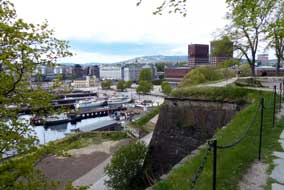 Akershus Slott
and the Hjemmefront (WW2 Resistance) Museum: more
cloud was gathering now threatening rain as we walked over to climb the rocky
knoll topped by Akershus Slott, Oslo's medieval castle. The original Slott had
been fortified around 1300 overlooking the harbour and withstood several sieges.
When Christian IV re-founded Oslo as Christiana following a city fire in 1624,
he transformed the medieval castle into a Renaissance palace surrounding it with
artillery-proof stone bastions and fortifications. We followed a pathway up into
the castle grounds onto the
Akershus Slott ramparts for the aerial view this gave across the
Oslo Fjord, waterfront and ferry
piers (see left) (Photo 24 - Oslo waterfront) (Photo 25 - View from
Akershus Slott Ramparts). Here we reached the Hjemmefront Museum whose
displays tell the story of the German invasion of April 1940, the 5 years of
occupation, the emergence of the Norwegian Resistance, through to liberation in
May 1945. Akershus Slott
and the Hjemmefront (WW2 Resistance) Museum: more
cloud was gathering now threatening rain as we walked over to climb the rocky
knoll topped by Akershus Slott, Oslo's medieval castle. The original Slott had
been fortified around 1300 overlooking the harbour and withstood several sieges.
When Christian IV re-founded Oslo as Christiana following a city fire in 1624,
he transformed the medieval castle into a Renaissance palace surrounding it with
artillery-proof stone bastions and fortifications. We followed a pathway up into
the castle grounds onto the
Akershus Slott ramparts for the aerial view this gave across the
Oslo Fjord, waterfront and ferry
piers (see left) (Photo 24 - Oslo waterfront) (Photo 25 - View from
Akershus Slott Ramparts). Here we reached the Hjemmefront Museum whose
displays tell the story of the German invasion of April 1940, the 5 years of
occupation, the emergence of the Norwegian Resistance, through to liberation in
May 1945.
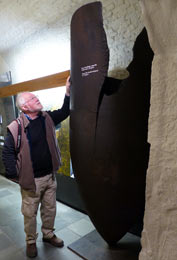 The displays detail the history of the carefully planned German invasion of
Norway with 1000s of Luftwaffe bombers spearheading the unexpected attack, the
battles for Narvik and Allies' withdrawal, and King Håkon VII and government
fleeing to England rejecting German demands to surrender and refusing to
acknowledge the Quisling's puppet regime; a recording of his whining radio broadcast urging Norwegians
to accept German terms was played. German censorship of the press and
confiscation of radios led to increasing publication of clandestine newssheets.
The Quisling regime's attempt to impose a programme of nazification provoked
strikes by clergy and teachers resulting in an enforced labour programme,
arrests, deportations and executions. Displays showed the emergence of an
increasingly organised Resistance, reinforced by arms and explosives drops from
Britain, and frequently betrayed by Norwegian collaborators and
informers. The Germans fortified Fortress Norway with 400,000 troops constantly
fearing an Allied invasion, and based the battleship Tirpitz in Norwegian
Fjords threatening the Arctic convoys until it was finally sunk near Tromsø; part of
one of the 12,000 lb Tallboy bombs dropped by RAF Lancasters was displayed
(see right) adding one further piece to our understanding of Tirpitz's history
(Photo 26 - Tallboy bomb dropped on Tirpitz).
The German scorched earth policy attempting to hold up the Soviet advance into
Finmark and Troms inflicted extreme material damage on the northern part of the
country, endorsed by Hitler's directive that any compassion for the civilian
population was misplaced. With the German surrender came liberation in May 1945,
and return of the King and Storting; Quisling was executed as a traitor a year
later. Superbly detailed and presented as the museum was, our one criticism was
the slightly over-bowdlerised implication of total national unity and opposition
to the Germans and their puppet Quisling, and little mention of fragmented
nature of resistance activity particularly by
communist factions. Little was said of the impact of collaboration or the
numbers of Nazi sympathisers joining the German forces. Doubtless Quisling's
traitorous regime was loathed as repulsive by the majority of Norwegians, but
little was reported of the considerable Nazi sympathisers among the bourgeoisie
or the The displays detail the history of the carefully planned German invasion of
Norway with 1000s of Luftwaffe bombers spearheading the unexpected attack, the
battles for Narvik and Allies' withdrawal, and King Håkon VII and government
fleeing to England rejecting German demands to surrender and refusing to
acknowledge the Quisling's puppet regime; a recording of his whining radio broadcast urging Norwegians
to accept German terms was played. German censorship of the press and
confiscation of radios led to increasing publication of clandestine newssheets.
The Quisling regime's attempt to impose a programme of nazification provoked
strikes by clergy and teachers resulting in an enforced labour programme,
arrests, deportations and executions. Displays showed the emergence of an
increasingly organised Resistance, reinforced by arms and explosives drops from
Britain, and frequently betrayed by Norwegian collaborators and
informers. The Germans fortified Fortress Norway with 400,000 troops constantly
fearing an Allied invasion, and based the battleship Tirpitz in Norwegian
Fjords threatening the Arctic convoys until it was finally sunk near Tromsø; part of
one of the 12,000 lb Tallboy bombs dropped by RAF Lancasters was displayed
(see right) adding one further piece to our understanding of Tirpitz's history
(Photo 26 - Tallboy bomb dropped on Tirpitz).
The German scorched earth policy attempting to hold up the Soviet advance into
Finmark and Troms inflicted extreme material damage on the northern part of the
country, endorsed by Hitler's directive that any compassion for the civilian
population was misplaced. With the German surrender came liberation in May 1945,
and return of the King and Storting; Quisling was executed as a traitor a year
later. Superbly detailed and presented as the museum was, our one criticism was
the slightly over-bowdlerised implication of total national unity and opposition
to the Germans and their puppet Quisling, and little mention of fragmented
nature of resistance activity particularly by
communist factions. Little was said of the impact of collaboration or the
numbers of Nazi sympathisers joining the German forces. Doubtless Quisling's
traitorous regime was loathed as repulsive by the majority of Norwegians, but
little was reported of the considerable Nazi sympathisers among the bourgeoisie
or the
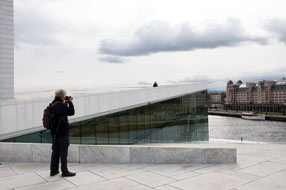 1000s of illegitimate babies born to Norwegian women from
'fraternisation' with Germans, and their treatment after the war. That said, the Hjemmefront
Museum is certainly worthy of a visit. 1000s of illegitimate babies born to Norwegian women from
'fraternisation' with Germans, and their treatment after the war. That said, the Hjemmefront
Museum is certainly worthy of a visit.
Oslo Opera House: with spots of rain now beginning and light gloomily dull, we walked across to
the grounds of the Akershus Fortress which is still occupied by the Norwegian
armed forces and eventually escaped from the military zone back safely into civvie street to make our way over to the easterly bay of the harbour to gaze
across the water at the modernist glass and white marble pyramidical structure
of the Oslo Opera House (Photo 27 - Oslo Opera House). Entering
the lofty glazed forecourt we enquired about guided tours but these only
happened on Wednesdays. We therefore followed others to walk up the
interconnected white marble shallow pyramidical 'ski slopes' of the structure's
roof
(Photo 28 - 'Ski-slope' roof of Oslo Opera House).
It sounds slightly fantastical, but that apparently is the thing that everyone
does; local people simply wandered up the shallow sloping roof with no seeming
purpose except the view from the top over the now gloomy harbour (see left). So we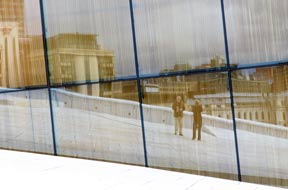 did
likewise, a most curious sensation, especially with the reflections in the huge
plate glass windows (see right) as we descended the 'ski slope'. did
likewise, a most curious sensation, especially with the reflections in the huge
plate glass windows (see right) as we descended the 'ski slope'.
In late afternoon traffic, we crossed to Sentral
Station where we had begun our visit to the capital 3 days ago, and ambled back
along the length Karl Johans gata for the last time to catch our bus back to the
campsite. Our time in Oslo had truly been memorable; we had learnt much and been
extremely fortunate with the early May Spring sunshine to brighten our
photographs. Most particularly, we recall our privileged visit to the Norwegian
Parliament; we were so grateful to Peder and Oliver, the 2 parliamentary
officials who had come to our rescue when the official public visit had been
cancelled. Through our web site we pass on our thanks for the time which they so generously had given to arrange our personalised visit to the Storting.
Tomorrow we should leave Oslo to begin our long journey northwards up the length
of this long country on the E6 highway. Our next edition detailing our travels
to south-eastern Norway, Lillehammer, the Eastern Jotunheimen Mountains
and Dovrefjell National Park will follow shortly; add the site to your Favourites/Bookmarks and join us again then.
Next edition
to be published quite soon
|
Sheila and Paul |
Published:
4 June 2014 at
Vestvågøya, Lofoten Islands |
|

 CAMPING
IN NORWAY 2014 - Norway's capital city Oslo:
CAMPING
IN NORWAY 2014 - Norway's capital city Oslo: The
outward journey: this year we had another 2-stage journey out
with the DFDS overnight ferry from Harwich to Esbjerg on the west coast of
Denmark and an afternoon's drive up through Jutland to the northern port of Hirtshals. After a frosty night's camp, the final leg of outward journey was
by Fjordline ferry across the Skagerrak to Langersund on the southern coast of Norway. The
Spring morning was beautifully sunny, the air still with not a ruffle of breeze, and
the notorious straits between Denmark and Norway were flat calm; we took our
departing photos of Hirtshals (see left) and settled into the comfortable
bow-lounge for the 4½ hour crossing. By 1-00pm the southern coastline of Norway
was growing closer, the low mountains covered with a dusting of overnight snow.
As the ferry approached the little port of Langersund, nudging slowly along the
narrow channel between the off-shore islands, we took our arrival photos (
The
outward journey: this year we had another 2-stage journey out
with the DFDS overnight ferry from Harwich to Esbjerg on the west coast of
Denmark and an afternoon's drive up through Jutland to the northern port of Hirtshals. After a frosty night's camp, the final leg of outward journey was
by Fjordline ferry across the Skagerrak to Langersund on the southern coast of Norway. The
Spring morning was beautifully sunny, the air still with not a ruffle of breeze, and
the notorious straits between Denmark and Norway were flat calm; we took our
departing photos of Hirtshals (see left) and settled into the comfortable
bow-lounge for the 4½ hour crossing. By 1-00pm the southern coastline of Norway
was growing closer, the low mountains covered with a dusting of overnight snow.
As the ferry approached the little port of Langersund, nudging slowly along the
narrow channel between the off-shore islands, we took our arrival photos ( traffic became heavier and speed limits
lower, and once within the
main area of the city the satnav guided us through residential areas to reach Bogstad Camping,
which was to be our base for our 3 days in the capital. Set at the foot of
wooded hills in Oslo's northern suburbs 9kms from the city centre, Bogstad
Camping is run by NAF, the Norwegian equivalent of the AA/RAC: reception staff
were helpfully welcoming providing street plan and details and tickets for the
#32 bus which runs regularly to/from the centre; facilities were rather
care-worn but the setting was pleasantly green and wooded with plenty of space;
there was a well-stocked mini-market next door and wi-fi at reception. But the
prices! 340 NOK/night (£34) was unprecedentedly exploitational even for NAF. But
there was little choice since this was the only
campsite open in early May. We settled in as the evening became chill, looking
forward to our 3 days exploring Norway's capital city.
traffic became heavier and speed limits
lower, and once within the
main area of the city the satnav guided us through residential areas to reach Bogstad Camping,
which was to be our base for our 3 days in the capital. Set at the foot of
wooded hills in Oslo's northern suburbs 9kms from the city centre, Bogstad
Camping is run by NAF, the Norwegian equivalent of the AA/RAC: reception staff
were helpfully welcoming providing street plan and details and tickets for the
#32 bus which runs regularly to/from the centre; facilities were rather
care-worn but the setting was pleasantly green and wooded with plenty of space;
there was a well-stocked mini-market next door and wi-fi at reception. But the
prices! 340 NOK/night (£34) was unprecedentedly exploitational even for NAF. But
there was little choice since this was the only
campsite open in early May. We settled in as the evening became chill, looking
forward to our 3 days exploring Norway's capital city. Oslo's
history: the oldest of the Scandinavian capital cities, Oslo's name is
derived from Old Norse words Às and Lo (meaning God's field). The
city was founded by Harald Hårdråda around 1048 and his son Olav Kyrre
established a bishopric there building a cathedral in the developing city. But
at this time royal power was based at Bergen until Håkon V moved the capital to
Oslo in the early 14th century fortifying the city with the Akershus castle. In
1349 bubonic plague wiped out half the population and the decline continued when
Norway fell under Danish control in 1397 with Oslo becoming a neglected
backwater. The city's fortunes revived in 1624 when the Danish King Christian IV
moved the city to its present site, modestly renaming it Christiana. The new
city prospered even after Norway was united with Sweden in 1814 and Jean-Baptiste
Bernadotte as King Karl XIV Johan built himself a grand new palace in Christiana
(see right) for the now united Kingdom of Sweden and Norway. Norway eventually
achieved her independent statehood in 1905, and the city finally regained its
original name of Oslo in 1925.
Oslo's
history: the oldest of the Scandinavian capital cities, Oslo's name is
derived from Old Norse words Às and Lo (meaning God's field). The
city was founded by Harald Hårdråda around 1048 and his son Olav Kyrre
established a bishopric there building a cathedral in the developing city. But
at this time royal power was based at Bergen until Håkon V moved the capital to
Oslo in the early 14th century fortifying the city with the Akershus castle. In
1349 bubonic plague wiped out half the population and the decline continued when
Norway fell under Danish control in 1397 with Oslo becoming a neglected
backwater. The city's fortunes revived in 1624 when the Danish King Christian IV
moved the city to its present site, modestly renaming it Christiana. The new
city prospered even after Norway was united with Sweden in 1814 and Jean-Baptiste
Bernadotte as King Karl XIV Johan built himself a grand new palace in Christiana
(see right) for the now united Kingdom of Sweden and Norway. Norway eventually
achieved her independent statehood in 1905, and the city finally regained its
original name of Oslo in 1925. was a feast of
elegant Baroque decoration, particularly the maroon, green and gold ceiling
paintings. Opposite the exuberantly Baroque pulpit, the Royal Box with Håkon
VII's monogram (Norway's first king after 1905 independence) looked as if
borrowed from the Opera House. Behind the choir too distant for close
examination, the Baroque high altar was decorated with a relief of the Last
Supper (
was a feast of
elegant Baroque decoration, particularly the maroon, green and gold ceiling
paintings. Opposite the exuberantly Baroque pulpit, the Royal Box with Håkon
VII's monogram (Norway's first king after 1905 independence) looked as if
borrowed from the Opera House. Behind the choir too distant for close
examination, the Baroque high altar was decorated with a relief of the Last
Supper ( once the city's main square adorned with a statue of
Christian IV who revived the city's fortune and renamed it Christiana in his own
honour; his royal presence now supervises a small flower market (
once the city's main square adorned with a statue of
Christian IV who revived the city's fortune and renamed it Christiana in his own
honour; his royal presence now supervises a small flower market (
 The
Royal Palace: in the now bright sunshine, we walked on towards the Kongelige
Slott (Royal
Palace) set on the hill ahead in the publically open parkland of Slottsparken
(
The
Royal Palace: in the now bright sunshine, we walked on towards the Kongelige
Slott (Royal
Palace) set on the hill ahead in the publically open parkland of Slottsparken
( to bolster military
powers around the world. We had reservations about this visit, but entry to the
Centre was today half price and we soon found out why: half the exhibits were
closed for renovation. The 2013 nomination for the Peace Prize was to the
Organisation for Prohibition of Chemical Weapons, an international movement with
a challenging mission, since 2 of the main offenders, Russia and USA, despite
being signatories to the banning convention have done nothing to destroy their
monumental stock-piles of chemical weapons; terrorist groups and pariah
states like North Korea and Syria ignore the ban.
to bolster military
powers around the world. We had reservations about this visit, but entry to the
Centre was today half price and we soon found out why: half the exhibits were
closed for renovation. The 2013 nomination for the Peace Prize was to the
Organisation for Prohibition of Chemical Weapons, an international movement with
a challenging mission, since 2 of the main offenders, Russia and USA, despite
being signatories to the banning convention have done nothing to destroy their
monumental stock-piles of chemical weapons; terrorist groups and pariah
states like North Korea and Syria ignore the ban.  So the OPCW spends its time
cleaning up WW1 battlefields in Belgium. The Nobel Peace Centre's modernistic
display of light-bulbs-on-stalks listed past Peace Prize winners including such
worthy organisations and individuals as the International Committee of Red
Cross, Lech Wałęsa, Desmond Tutu, Martin Luther King, Nelson Mandela, Willy
Brandt and Mikhail Gorbachev. But over its 100 years of history, the Prize had
been awarded to some bizarrely dubious un-worthies like Theodore Roosevelt who
had extended US imperialism stirring up wars in Latin America, and Henry
Kissinger who had prolonged the Vietnam War by invading Cambodia. All in all we
were not impressed with the cynical Alfred Nobel, his Peace Prize or his Peace
Centre
(
So the OPCW spends its time
cleaning up WW1 battlefields in Belgium. The Nobel Peace Centre's modernistic
display of light-bulbs-on-stalks listed past Peace Prize winners including such
worthy organisations and individuals as the International Committee of Red
Cross, Lech Wałęsa, Desmond Tutu, Martin Luther King, Nelson Mandela, Willy
Brandt and Mikhail Gorbachev. But over its 100 years of history, the Prize had
been awarded to some bizarrely dubious un-worthies like Theodore Roosevelt who
had extended US imperialism stirring up wars in Latin America, and Henry
Kissinger who had prolonged the Vietnam War by invading Cambodia. All in all we
were not impressed with the cynical Alfred Nobel, his Peace Prize or his Peace
Centre
( today
on our behalf! They introduced themselves as Peder and Oliver, and we arranged
to meet them an hour later by the main entrance at the Parliament's curved
frontage (see right). They both
today
on our behalf! They introduced themselves as Peder and Oliver, and we arranged
to meet them an hour later by the main entrance at the Parliament's curved
frontage (see right). They both
 worked as Political Advisors for the governing Høyres stortingetsgruppe (Conservative Party Group) under Prime Minister Erna
Solberg, and led us into the main lobby of Parliament. Having passed through the
security screening, they showed us around the formal rooms and up the formal
staircase into the Storting's plenary chamber (see left). It was certainly the
most ornate parliamentary chamber we had seen, decorated in crimson and gilding
with the royal coat of arms above the President's (Speaker's) chair. The
worked as Political Advisors for the governing Høyres stortingetsgruppe (Conservative Party Group) under Prime Minister Erna
Solberg, and led us into the main lobby of Parliament. Having passed through the
security screening, they showed us around the formal rooms and up the formal
staircase into the Storting's plenary chamber (see left). It was certainly the
most ornate parliamentary chamber we had seen, decorated in crimson and gilding
with the royal coat of arms above the President's (Speaker's) chair. The  Our second day in Oslo - ferry across the Oslo Fjord to the Viking Ship
Museum and Fram Museum at Bygdøy: after a chill night, we again
caught the #32 bus into the city to spend our second day visiting 2 of the
museums on the peninsula of Bygdøy, crossing Oslo Fjord on the small ferry which
runs regularly from pier #3 at Rådhusbrygge behind the City Hall
(
Our second day in Oslo - ferry across the Oslo Fjord to the Viking Ship
Museum and Fram Museum at Bygdøy: after a chill night, we again
caught the #32 bus into the city to spend our second day visiting 2 of the
museums on the peninsula of Bygdøy, crossing Oslo Fjord on the small ferry which
runs regularly from pier #3 at Rådhusbrygge behind the City Hall
( seniors' reduction. Bright morning sunshine lit the Oslo
waterfront and City Hall as the ferry crossed the fjord harbour (see left), and
within 10 minutes the boat pulled into the Dronningen dock on Bygdøy. From here
it was a short walk up the hill through a quiet residential suburb to the
Vikingskipshuset (Viking Ship Museum) on peninsula's crest. The large
cruciform building was specially constructed to house the remains of three
9th century AD Viking longboats recovered from burial mounds around the Oslo
Fjord at the turn of the 19/20th centuries. Viking custom was to bury its
chieftains in their ships accompanied by ritually killed slaves and all the
accoutrements needed for noble life in Valhalla. The acidic soil of the burial
mound covering the Bygdøy ships had preserved their oak timbers in almost
perfect condition.
seniors' reduction. Bright morning sunshine lit the Oslo
waterfront and City Hall as the ferry crossed the fjord harbour (see left), and
within 10 minutes the boat pulled into the Dronningen dock on Bygdøy. From here
it was a short walk up the hill through a quiet residential suburb to the
Vikingskipshuset (Viking Ship Museum) on peninsula's crest. The large
cruciform building was specially constructed to house the remains of three
9th century AD Viking longboats recovered from burial mounds around the Oslo
Fjord at the turn of the 19/20th centuries. Viking custom was to bury its
chieftains in their ships accompanied by ritually killed slaves and all the
accoutrements needed for noble life in Valhalla. The acidic soil of the burial
mound covering the Bygdøy ships had preserved their oak timbers in almost
perfect condition. positions. The ship was uncovered with a large wooden burial chamber set on its
deck forward of the mast, with the skeletal remains of 2 women thought to be a
chieftain's wife and her attendant. It also contained a startling collection of
grave goods including 3 elaborately carved wooden sledges, a large wooden wagon,
ornately carved animal heads as well as a treasure trove of more mundane
domestic articles for use in the after life. We spent time photographing the
ship, its clinker-built planking and the detailed carvings along the length of the keel
(see left) which curved up to
the high prow and stern. Viewing galleries at each corner of the cruciform
centre of the halls allowed an overview of the ship's decking.
positions. The ship was uncovered with a large wooden burial chamber set on its
deck forward of the mast, with the skeletal remains of 2 women thought to be a
chieftain's wife and her attendant. It also contained a startling collection of
grave goods including 3 elaborately carved wooden sledges, a large wooden wagon,
ornately carved animal heads as well as a treasure trove of more mundane
domestic articles for use in the after life. We spent time photographing the
ship, its clinker-built planking and the detailed carvings along the length of the keel
(see left) which curved up to
the high prow and stern. Viewing galleries at each corner of the cruciform
centre of the halls allowed an overview of the ship's decking.

 It
was a short walk down to the Bygdøy dock for the Fram Museum, which is made up
of 2 fjord-side huge triangular tent-shaped buildings housing the Fram and
Gjøa, the 2 boats associated with the polar expeditions of the 2 Norwegian
explorers Roald Amundsen (1872~1928) and Fridtjof Nansen (1861~1930),
(
It
was a short walk down to the Bygdøy dock for the Fram Museum, which is made up
of 2 fjord-side huge triangular tent-shaped buildings housing the Fram and
Gjøa, the 2 boats associated with the polar expeditions of the 2 Norwegian
explorers Roald Amundsen (1872~1928) and Fridtjof Nansen (1861~1930),
( heading for the Pole. Applying the experience learnt from North Canadian Inuit
during his
heading for the Pole. Applying the experience learnt from North Canadian Inuit
during his
 NW Passage expedition of 1903~06 in the Gjøa
of using windproof clothing (furs and anoraks) for protection and husky dogs to
haul sledges, he successfully reached the South Pole in 1912, beating his
British rival Captain Robert Scott by a month. The members of Scott's
expedition all perished on their return march from the Pole. Three galleries of
displays and exhibits told the story of Nansen and Amundsen's polar ventures in
commendable detail with excellent multi-lingual commentaries. From the highest
gallery, a gang-plank led across onto the Fram's deck (see left) with steps down
into the confined quarters of the ship with displays detailing the equipment
taken on the polar expedition
(
NW Passage expedition of 1903~06 in the Gjøa
of using windproof clothing (furs and anoraks) for protection and husky dogs to
haul sledges, he successfully reached the South Pole in 1912, beating his
British rival Captain Robert Scott by a month. The members of Scott's
expedition all perished on their return march from the Pole. Three galleries of
displays and exhibits told the story of Nansen and Amundsen's polar ventures in
commendable detail with excellent multi-lingual commentaries. From the highest
gallery, a gang-plank led across onto the Fram's deck (see left) with steps down
into the confined quarters of the ship with displays detailing the equipment
taken on the polar expedition
(
 surprising that this
modernistic, cuboid, dark brick structure which with its twin square towers
which dominates the
waterfront, lacking any subtlety, grace or charm (see
right), had met initially with universal condemnation as a markedly un-Nordic
intrusion into the city's skyline. The original idea of a new city hall to be
built on an area of slum clearance by the harbour dated from 1915. Arneberg and
Poulsson won the architectural competition to create a grandiose statement of
city pride with their final design of 1930, combining, it was said, various
artistic trends of the period, national romanticism, classicism and
functionalism. Work began in 1931 to create the new harbour-side city centre
with the new City Hall towering over the ambitious development. WW2 delayed
completion and the building was finally opened in 1950. Now surrounded by even
more alien glass
and concrete structures, the City Hall has become accepted as
part of Oslo's city-scape, albeit still with its unique design (
surprising that this
modernistic, cuboid, dark brick structure which with its twin square towers
which dominates the
waterfront, lacking any subtlety, grace or charm (see
right), had met initially with universal condemnation as a markedly un-Nordic
intrusion into the city's skyline. The original idea of a new city hall to be
built on an area of slum clearance by the harbour dated from 1915. Arneberg and
Poulsson won the architectural competition to create a grandiose statement of
city pride with their final design of 1930, combining, it was said, various
artistic trends of the period, national romanticism, classicism and
functionalism. Work began in 1931 to create the new harbour-side city centre
with the new City Hall towering over the ambitious development. WW2 delayed
completion and the building was finally opened in 1950. Now surrounded by even
more alien glass
and concrete structures, the City Hall has become accepted as
part of Oslo's city-scape, albeit still with its unique design ( the Nobel Peace Prize award ceremony held each December
(
the Nobel Peace Prize award ceremony held each December
( Akershus Slott
and the Hjemmefront (WW2 Resistance) Museum: more
cloud was gathering now threatening rain as we walked over to climb the rocky
knoll topped by Akershus Slott, Oslo's medieval castle. The original Slott had
been fortified around 1300 overlooking the harbour and withstood several sieges.
When Christian IV re-founded Oslo as Christiana following a city fire in 1624,
he transformed the medieval castle into a Renaissance palace surrounding it with
artillery-proof stone bastions and fortifications. We followed a pathway up into
the castle grounds onto the
Akershus Slott ramparts for the aerial view this gave across the
Oslo Fjord, waterfront and ferry
piers (see left) (
Akershus Slott
and the Hjemmefront (WW2 Resistance) Museum: more
cloud was gathering now threatening rain as we walked over to climb the rocky
knoll topped by Akershus Slott, Oslo's medieval castle. The original Slott had
been fortified around 1300 overlooking the harbour and withstood several sieges.
When Christian IV re-founded Oslo as Christiana following a city fire in 1624,
he transformed the medieval castle into a Renaissance palace surrounding it with
artillery-proof stone bastions and fortifications. We followed a pathway up into
the castle grounds onto the
Akershus Slott ramparts for the aerial view this gave across the
Oslo Fjord, waterfront and ferry
piers (see left) ( The displays detail the history of the carefully planned German invasion of
Norway with 1000s of Luftwaffe bombers spearheading the unexpected attack, the
battles for Narvik and Allies' withdrawal, and King Håkon VII and government
fleeing to England rejecting German demands to surrender and refusing to
acknowledge the Quisling's puppet regime; a recording of his whining radio broadcast urging Norwegians
to accept German terms was played. German censorship of the press and
confiscation of radios led to increasing publication of clandestine newssheets.
The Quisling regime's attempt to impose a programme of nazification provoked
strikes by clergy and teachers resulting in an enforced labour programme,
arrests, deportations and executions. Displays showed the emergence of an
increasingly organised Resistance, reinforced by arms and explosives drops from
Britain, and frequently betrayed by Norwegian collaborators and
informers. The Germans fortified Fortress Norway with 400,000 troops constantly
fearing an Allied invasion, and based the battleship Tirpitz in Norwegian
Fjords threatening the Arctic convoys until it was finally sunk near Tromsø; part of
one of the 12,000 lb Tallboy bombs dropped by RAF Lancasters was displayed
(see right) adding one further piece to our understanding of Tirpitz's history
(
The displays detail the history of the carefully planned German invasion of
Norway with 1000s of Luftwaffe bombers spearheading the unexpected attack, the
battles for Narvik and Allies' withdrawal, and King Håkon VII and government
fleeing to England rejecting German demands to surrender and refusing to
acknowledge the Quisling's puppet regime; a recording of his whining radio broadcast urging Norwegians
to accept German terms was played. German censorship of the press and
confiscation of radios led to increasing publication of clandestine newssheets.
The Quisling regime's attempt to impose a programme of nazification provoked
strikes by clergy and teachers resulting in an enforced labour programme,
arrests, deportations and executions. Displays showed the emergence of an
increasingly organised Resistance, reinforced by arms and explosives drops from
Britain, and frequently betrayed by Norwegian collaborators and
informers. The Germans fortified Fortress Norway with 400,000 troops constantly
fearing an Allied invasion, and based the battleship Tirpitz in Norwegian
Fjords threatening the Arctic convoys until it was finally sunk near Tromsø; part of
one of the 12,000 lb Tallboy bombs dropped by RAF Lancasters was displayed
(see right) adding one further piece to our understanding of Tirpitz's history
( 1000s of illegitimate babies born to Norwegian women from
'fraternisation' with Germans, and their treatment after the war. That said, the Hjemmefront
Museum is certainly worthy of a visit.
1000s of illegitimate babies born to Norwegian women from
'fraternisation' with Germans, and their treatment after the war. That said, the Hjemmefront
Museum is certainly worthy of a visit.  did
likewise, a most curious sensation, especially with the reflections in the huge
plate glass windows (see right) as we descended the 'ski slope'.
did
likewise, a most curious sensation, especially with the reflections in the huge
plate glass windows (see right) as we descended the 'ski slope'. 